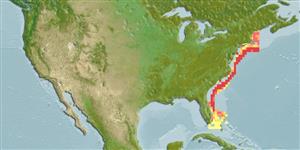Elasmobranchi (squali e razze) (sharks and rays) >
Rajiformes (Skates and rays) >
Rajidae (Skates)
Etymology: Leucoraja: Greek, leykos = white + Latin, raja = a fish, Raja sp. (Ref. 45335).
Eponymy: Dr Samuel Trevor Walton Garman (1843–1927) was an American naturalist, most noted as an ichthyologist and herpetologist. [...] (Ref. 128868), visit book page.
More on author: Whitley.
Environment: milieu / climate zone / depth range / distribution range
Ecologia
marino batidemersale; oceanodromo (Ref. 51243); distribuzione batimetrica 33 - 530 m (Ref. 106604). Subtropical; 9°C - 17°C (Ref. 41312); 44°N - 24°N, 81°W - 69°W
Western Atlantic.
Leucoraja garmani contains two valid subspecies: Leucoraja garmani caribbaea. (McEachran, 1977) and Leucoraja garmani virginica
(McEachran, 1977); here considered as junior synonyms.
Length at first maturity / Size / Peso / Age
Maturity: Lm ?, range 34 - ? cm
Max length : 57.0 cm TL maschio/sesso non determinato; (Ref. 106604)
Rows of spines along back and sides of tail. Tail rather long. Conspicuous dark rosettes on upper surface of disk in young and adults. Axil of pelvic fin to 1st dorsal fin greater than from axil of pelvic fin to eye (Ref. 7251). Upper surface pale buff or brown freckled with small spots, darker or paler. Lower surface white or pale yellow (Ref. 6902).
Occur mostly on outer edge of continental shelf and upper part of continental slope (Ref. 7251). Known salinities at which it has been taken 33.8 off Block Island to 35.3 off Chesapeake bay (Ref. 6902). Feed mostly on decapod crustaceans and to a lesser extent on amphipods, polychaetes, squids and fishes. Oviparous (Ref. 50449). Distinct pairing with embrace. Young may tend to follow large objects, such as their mother (Ref. 205). Eggs are oblong capsules with stiff pointed horns at the corners deposited in sandy or muddy flats (Ref. 205). Egg capsules are 3.7-5.4 cm long and 2.6-3.0 cm wide (Ref. 41301, 41298). Marketed fresh and salted (Ref. 3824).
Oviparous, paired eggs are laid. Embryos feed solely on yolk (Ref. 50449). Distinct pairing with embrace. Young may tend to follow large objects, such as their mother (Ref. 205).
McEachran, J.D. and K.A. Dunn, 1998. Phylogenetic analysis of skates, a morphologically conservative clade of elasmobranchs (Chondrichthyes: Rajidae). Copeia 1998(2):271-290. (Ref. 27314)
IUCN Red List Status (Ref. 130435: Version 2024-1)
Threat to humans
Harmless
Human uses
Pesca: scarso interesse commerciale; esca: occasionally
Strumenti
Special reports
Download XML
Fonti Internet
Estimates based on models
Preferred temperature (Ref.
123201): 10 - 23.2, mean 18.3 °C (based on 20 cells).
Phylogenetic diversity index (Ref.
82804): PD
50 = 0.5000 [Uniqueness, from 0.5 = low to 2.0 = high].
Bayesian length-weight: a=0.00251 (0.00171 - 0.00368), b=3.17 (3.05 - 3.29), in cm total length, based on LWR estimates for this species & Genus-body shape (Ref.
93245).
Trophic level (Ref.
69278): 3.6 ±0.0 se; based on diet studies.
Resilienza (Ref.
120179): Basso, tempo minimo di raddoppiamento della popolazione 4.5 - 14 anni (Fec assumed to be <100).
Fishing Vulnerability (Ref.
59153): Moderate vulnerability (43 of 100).
Nutrients (Ref.
124155): Calcium = 7.79 [0.85, 125.68] mg/100g; Iron = 0.442 [0.039, 5.145] mg/100g; Protein = 16.8 [14.7, 18.9] %; Omega3 = 0.328 [0.129, 0.815] g/100g; Selenium = 15.4 [2.5, 74.0] μg/100g; VitaminA = 43.3 [3.2, 514.0] μg/100g; Zinc = 0.701 [0.049, 8.046] mg/100g (wet weight);
